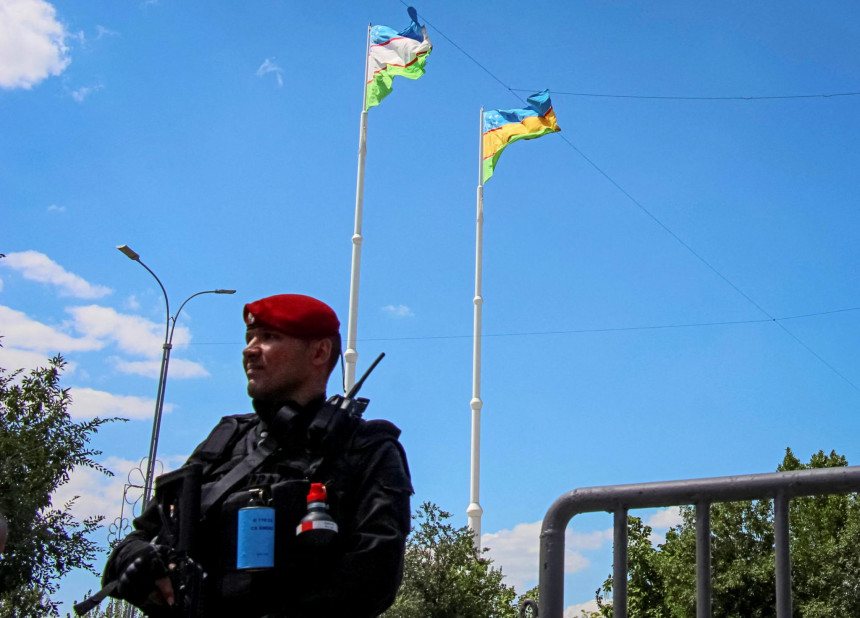The ethnic conflicts in Central Asia in the 21st century are a consequence of Stalin's policy decisions in the early 20th century

Last weekend, Karakalpakstan, an autonomous republic within Uzbekistan, was swept by a wave of violent and bloody protests. Upon learning that the planned amendments to the Uzbek constitution would no longer contain the article that Karakalpakstan is a sovereign republic with the theoretical possibility of seceding from Uzbekistan by referendum, mass riots broke out in Nukus, the capital of Karakalpakstan, and elsewhere.
On the evening of July 2, the President of Uzbekistan, Shavkat Mirziyoyev, arrived in the rebel republic and promised that the Uzbek constitution would not, after all, be amended in a way that would undermine the autonomy of Karakalpakstan. At the same time, a state of emergency was imposed in Karakalpakstan for one month, banning protests and demonstrations.
In 1986, I had the opportunity to take part in an extreme hike, which involved crossing the Kyzylkum Desert, 170 km in six days. Half of the journey was through Karakalpakstan. One of the surprises of this trip was the complete domination of the Kazakhs outside the cities. All the locals we met on the road - sheepherders and other workers of local agricultural enterprises (kolkhozes and sovkhozes) - were Kazakh. The locals explained that only Kazakhs farmed in all the areas suitable for agriculture in that part of the country, while Uzbeks lived more in the towns and river valleys. This observation only confirms what was realized much later, that the drawing of the borders dividing Central Asia into Soviet republics under the USSR was based on political decisions and not on correct ethnic separation.
The current borders of the independent Central Asian states were drawn by the Russian dictator Stalin. After the Bolshevik coup in 1917, Stalin was (until 1923) "Minister for Ethnic Minorities" or Commissar of Nationalities. The duties of the Commissar of Nationalities included defining the administrative boundaries of ethnic minority autonomies and Soviet republics. It was Stalin who was responsible for the creation of three autonomous territories in Georgia, which after the collapse of the USSR became the cause of war and unrest, while two former autonomies (Abkhazia and South Ossetia) still maintain the tension of military conflict in Georgia. Stalin is responsible for the incorporation of the Armenian-populated Karabakh into Azerbaijan, etc. As General Secretary of the USSR Communist Party and dictator, Stalin continued to decide on the administrative division of the USSR. Borders were constantly changed, some nationalities were deported, other nationalities were placed on their territories, etc. In Central Asia, relative border stability only came after 1936, when a new constitution of the USSR was approved. From then on, the division of the united republics stabilized, remaining unchanged until the collapse of the USSR.
After the end of the civil war in Russia, two autonomous republics (ASSRs) of very large size were created in Central Asia - Kyrgyzstan and Turkestan, which were part of the Russian Federation. Two much smaller territories, Bukhara and Khorezm, were formally people's Soviet republics. In 1924, the southern part of the Turkestan ASSR was separated from the Russian Federation to form the United Republics of Turkmenistan and Uzbekistan (SSR). The territory of the former Soviet republics of Bukhara and Khorezm was divided between the Turkmen SSR and the Uzbek SSR. At that time, Tajikistan had only the status of an autonomous republic within the Uzbek SSR.
From the northern part of the Turkestan ASSR and the so-called Kyrgyz ASSR, two autonomous republics, the Kazakh ASSR and the Kara-Kyrgyz ASSR, were created by a boundary reshuffle and remained part of the Russian Federation until 1936. In 1936, these territories were separated from the Russian Federation and the Kara-Kyrgyz ASSR became the Kyrgyz SSR (within the borders of present-day Kyrgyzstan).
The Kazakh ASSR, in turn, until 1936 included the entire territory of present-day Kazakhstan and Karakalpakstan, which had the status of an autonomous oblast. When the Kazakh ASSR was reorganized, Kazakhstan acquired the status of a constituent republic to the USSR, while the Karakalpakstan autonomy, ethnically close to the Kazakhs, was annexed to Uzbekistan as an autonomous republic.
After the First World War and the freedom fights, the borders between the Baltic States were drawn on the basis of ethnicity, but in the Communist-ruled Soviet Union, Stalin was guided by different principles - political expediency. Many areas of the fertile Fergana Valley, inhabited by Uzbeks, were annexed to then-poor Tajikistan and Kyrgyzstan to improve their development prospects. Since then, these lands have been inhabited by a very large Uzbek ethnic minority, which already caused many conflicts during the collapse of the USSR (Osh riots). At a time when Samarkand was the capital of Uzbekistan, Kazakh communist leaders began to lobby for Tashkent to be declared the capital of Kazakhstan. Stalin found it convenient to support the Uzbek Communists, so Stalin resolved the issue easily. In 1930, the Uzbek capital was moved from Samarkand to Tashkent, and so on.
Many of Stalin's decisions to arbitrarily change borders were the precursor of the later ethnic conflicts that followed the collapse of the USSR, both in the Transcaucasus and in Central Asia.
The Uzbek President's desire to avoid the risk of separatism that a constitutionally enshrined right of self-determination for Karakalpakstan could entail is understandable. Such a constitutionally guaranteed right could at some point be used by Islamic extremists from neighboring Afghanistan or by a superpower (such as Russia) to destabilize the situation in Uzbekistan.
This time, a quick attempt to centralize the Uzbek leadership in order to prevent the risks of future separatism appears to have failed.
*****
Be the first to read interesting news from Latvia and the world by joining our Telegram and Signal channels.
